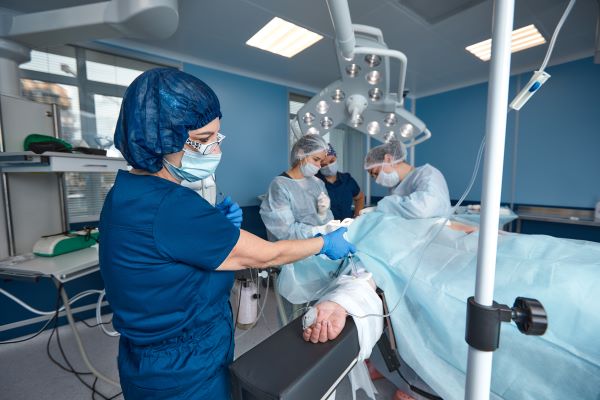Anesthesiology professionals are an important part of the practice of medicine, and anesthesiologist assistants are part of the anesthesia care team. If you want to be involved in the area of medicine concerned with administering pain-relieving and loss of consciousness-inducing medications – but you don’t want to spend several years going to medical school, completing your clinical internship and undertaking specialized fellowship training – a job as an anesthesiologist assistant may be for you.
Anesthesiology assistants still require a formal college education and training programs, but becoming an anesthesiologist assistant doesn’t require the same time commitment as becoming an anesthesiologist. However, only a small number of universities across the United States offer the specialized education necessary to prepare for an anesthesiologist assistant job.
An Assistant’s Role in the Anesthesia Care Team
The anesthesia care team is the part of a patient’s medical team that is responsible for the administration of anesthesia. In other words, the anesthesia care team, led by a licensed anesthesiologist, uses special anesthesia delivery systems to administer medications that induce a loss of consciousness or a loss of sensation or sensitivity to pain.
There are numerous healthcare professionals involved in an anesthesia care team. Each anesthesia care team is led by a qualified anesthesiologist. The anesthesiologist retains ultimate responsibility for patient safety and quality anesthesia care as given by the highly skilled professionals they supervise.
Anesthesiologist
The specialist physicians, or medical doctors, who specialize in the administration of anesthesia are called anesthesiologists. As the most highly trained and educated part of the anesthesia care team, the anesthesiologist is responsible for training and supervising personnel who make up the anesthesiology team and for overseeing the work of other members of the team, such as the anesthesiologist assistant.
RELATED: What Is the Typical Day for an Anesthesiologist?
Anesthesiologist Assistant
An anesthesiologist assistant is a specialized type of physician assistant, or PA, who is trained extensively in anesthesiology practice and the use of anesthesia delivery systems to administer medications for pain relief and loss of sensation and consciousness.
A physician assistant is a highly trained clinical professional with a master’s-level education who practices medicine under the guidance of a licensed doctor.
The anesthesia care anesthesia assistants administer is performed under the direction of licensed anesthesiologists. As such, you can think of anesthesiologist assistants as physician extenders, because they are qualified to provide anesthesia care while working under a responsible anesthesiologist. For every anesthetic medication anesthesiologist assistants administered, the anesthesiologist can oversee the treatment procedures essential to surgeries and other medical interventions of a greater number of patients who need them.
Anesthesiologist assistants must acquire professional credentials to work in clinical practice. The National Commission for Certification of Anesthesiologist Assistants (NCCAA) awards the Certified Anesthesiologist Assistant (CAA) credential to professionals who meet eligibility requirements and pass the Certifying Examination for Anesthesiologist Assistants.
Because anesthesiology is a unique area of medical specialty, aspiring anesthesiologist assistants can’t just enroll in any PA program. They must pursue a Master of Science in Anesthesia program, also called an Anesthesiologist Assistant program or AA program, that covers the basics of PA training as well as the specialized anesthesia science curriculum.
Nurse Anesthetist
Anesthesiologist assistants aren’t the only non-physician roles on the anesthesia care team. The team also includes nurse anesthetists, or Certified Registered Nurse Anesthetists (CRNAs). Nurse anesthetist is a type of advanced practice registered nurse specializing in anesthesia administration.
There are two major differences between anesthesiologist assistants and nurse anesthetists: the ability to practice independently and the approach to patient care.
RELATED: What Is the Difference Between an Anesthesiologist vs Nurse Anesthetist?
While anesthesiologist assistants must practice medicine under the direction of a licensed anesthesiologist, nurse anesthetists may be permitted to provide anesthetic care independently, depending on state law and other factors. More than half of the states in the U.S. allow for the independent practice of CRNAs, according to the National Council of State Boards of Nursing.
Nurse anesthetists and anesthesiologist assistants both provide anesthesia care, but they approach the field from different perspectives. CRNAs are trained in the nursing model of patient care, which places special emphasis on the whole patient’s needs. Anesthesiologist assistants and other PAs, like physicians, are instead trained according to the medical model, which emphasizes the anatomical parts and physiological systems of the body and utilizes disease-oriented approaches to patient care and treatment.
What Do Anesthesiologist Assistants Do?
Like other members of the anesthesiology team, anesthesiologist assistants administer local anesthetics, perform regional anesthesia techniques and put patients to “sleep” under general anesthesia. Whatever type of anesthesia they are administering, it’s their job to provide compassionate and quality care in the administration of anesthetics.
Anesthesiologist assistants perform many of the same job responsibilities that anesthesiologists and nurse anesthetists do. They take patients’ preliminary preanesthetic health history and perform a preanesthetic physical examination. Anesthesiologist assistants use this patient data to develop and implement anesthesia care plans – choosing the appropriate types and dosages of anesthesia medications to administer. They implement anesthesia care plans, including inserting catheters to be used in anesthesia administration and operating the equipment used in anesthesia delivery systems.
Administering anesthesia is challenging, as using too much or too little of these powerful drugs can be dangerous for the patient. As such, anesthesiologist assistants are highly involved in patient monitoring before administration, throughout the procedure and as the patient is coming out of anesthesia during the postoperative recovery period.
To accomplish this, they are responsible for establishing noninvasive and invasive routine monitoring modalities that allow them to monitor the patient’s current physical status and be aware of any cause for concern. Anesthesiologist assistants use advanced patient monitoring techniques, such as pulmonary artery catheterization. Altering anesthesia levels as needed based on a patient assessment is also part of anesthetist practice.
One reason anesthesiologist assistants must work under the direction of licensed anesthesiologists is because there are risks involved in anesthesia administration, as in other aspects of undergoing surgical procedures. An anesthesiologist assistant has to be prepared for potential complications and trained to perform life-saving interventions, like cardiopulmonary resuscitation (CPR) and advanced cardiac life support measures, in the event that something goes wrong.
Generally, members of the anesthesia care team must be familiar with basic life support and advanced life support techniques, including pediatric advanced life support and advanced cardiac life support.
What differentiates anesthesiologist assistants from anesthesiologists is largely their capability to practice medicine independently. Licensed anesthesiologists and other licensed physicians are authorized to practice medicine independently, but anesthesiologists and other types of physician assistants must work under the direction and guidance of a supervising anesthesiologist.
This requirement is in place because, as non-physicians, anesthesiologist assistants don’t have the same extent of education and training as licensed doctors. For the same reason, anesthesiologist assistants can expect to earn salaries that are considerably less than what licensed anesthesiologists earn, although the job is still considered lucrative.
Employment of Anesthesiologist Assistants
Anesthesiologist assistant isn’t a new career path. In fact, the first anesthesiologist assistant programs date back more than half a century, according to Purdue University. However, anesthesiologist assistant is still a very small occupation. Despite this, anesthesiologist assistants are in high demand in the work settings where they are authorized to practice.
Only 20 jurisdictions – 19 states and Washington, D.C. – currently allow Certified Anesthesiologist Assistants to practice, according to the American Society of Anesthesiologists. As such, there are far fewer anesthesiologist assistants than anesthesiologists or nurse anesthetists.
The Iowa Society of Anesthesiologists puts the number of anesthesiologist assistants at just 1,800. In comparison, the United States Bureau of Labor Statistics recognized 31,130 anesthesiologists and 43,950 nurse anesthetists as of 2021.
Where Do Anesthesiologist Assistants Work?
Generally, anesthesiologist assistants work in the same settings as anesthesiologists and nurse anesthetists. Hospitals often employ anesthesiologist assistants in their intensive care units, trauma centers, emergency care departments, operating rooms and labor and delivery departments. Outpatient surgery centers, pain clinics, birthing centers and other medical facilities where anesthesia administration may be required are examples of the other types of work settings for anesthesiologist assistants.
Where you work may affect your work schedule, as well. If you work in a clinic or outpatient surgical center with regular business hours and administer anesthesia only for scheduled procedures, you may work more regular hours. If you work in the intensive care unit, trauma unit or emergency department of a hospital, where a patient may need to undergo an unplanned surgery at any time of day or night, you may end up working late-night shifts, weekends and holidays. Certified Anesthesiologist Assistants may also be on call during certain days or times.

Anesthesiologist Assistant Salary
Given the extensive education and training needed to work as an anesthesiologist assistant and the importance of the job, it should come as no surprise that these professionals earn high salaries.
Salary.com reported that most anesthesiologist assistants earn between $136,439 and $206,670 annually, with an average salary of $167,489 as of 2022. That’s somewhat lower than the wages reported for nurse anesthetists, despite the American Academy of Anesthesiologist Assistants (AAAA)’s assertion that anesthesiologist assistants receive “identical salary and benefit packages” as nurse anesthetists working in the same facility and department and having the same level of experience and job responsibilities. For nurse anesthetists, the Bureau of Labor Statistics reported a median of $195,610 and an average of $202,470 as of 2021.
RELATED: Top 50 Highest Paying Master’s Degrees
A licensed anesthesiologist, naturally, can earn considerably more than either CRNAs or CAAs. For anesthesiologists, the Bureau of Labor Statistics reported an average salary of $331,190 for 2021.
How to Become an Anesthesiologist Assistant
If you want to become an anesthesiologist assistant, you’re going to need to complete a specialized master’s degree program that, as of 2022, is only offered at 10 universities in the United States. Your first step on the path to an anesthesiologist assistant career will be earning a bachelor’s degree.
Earning a Bachelor’s Degree
Preparing for an anesthesiologist assistant program begins early. First, you’re going to need to earn a bachelor’s degree. There is no one baccalaureate degree that is required for entrance into an anesthesiologist assistant program, but developing an undergraduate background in science is critical for admission into and success in an anesthesiologist assistant program.
Undergraduate students should take classes in general and molecular biology, human anatomy and physiology, general chemistry, organic chemistry, general physics and calculus. No matter which formal major a student chooses to pursue, completing a premedical track as an undergraduate is beneficial.
Getting into an anesthesiologist assistant program – or any PA program, for that matter – is challenging. Throughout their undergraduate studies, students must make sure to maintain a high GPA if they are coming to be competitive candidates for admission.
Additionally, aspiring anesthesiologist assistants must meet entrance testing requirements for the program to which they are applying. Depending on their intended program, students may take the Medical College Admissions Test (MCAT) – the same test required to get into medical school – or the Graduate Records Admission Test (GRE), according to the American Academy of Anesthesiologist Assistants.
Earning a Master’s Degree From an Accredited Anesthesia Program
Earning a bachelor’s degree is the precursor to pursuing a master’s degree, which is the level of education required to become an anesthesiologist assistant. Not just any master’s program will do. Students must complete a specialized master’s degree program in anesthesia or anesthesia science that includes a clinical portion of instruction.
Only graduates from accredited graduate programs qualify for certification and professional practice in this field. Anesthesiologist assistant programs must be accredited by the Commission on Accreditation of Allied Health Education Programs (CAAHEP). As of 2022, the Commission on Accreditation of Allied Health Education Programs accredits AA training programs at only 10 universities across the United States, according to the American Academy of Anesthesiologist Assistants.
These institutions that offer an accredited anesthesia program include:
- Case Western Reserve University, with locations in Cleveland, OH; Houston, TX; Austin, TX; and Washington, D.C.
- Nova Southeastern University, with locations in Fort Lauderdale, FL; Tampa, FL; Jacksonville, FL; and Denver-Centennial, CO
- Emory University in Atlanta, GA
- South University, with locations in Savannah, GA and West Palm Beach, FL
- Medical College of Wisconsin in Milwaukee, WI
- University of Missouri – Kansas City in Kansas City, MO
- University of Colorado in Denver, CO
- Indiana University in Indianapolis, IN
- Ohio Dominican University in Columbus, OH
- Northeast Ohio Medical University (NEOMED) in Rootstown, OH
There are specific requirements for institutions that offer accredited anesthesiologist assistant programs. The institutions must either have a medical school or collaborate with a medical school that includes at least one academic anesthesiologist physician faculty member. At least one of the directors of the program needs to be a licensed, board-certified anesthesiologist. Clinical instruction is mandatory in an accredited AA educational program.
To apply to accredited AA programs, students must use the Central Application Service for Anesthesiologist Assistant Programs (CASAA).
Getting Initial Certification as a CAA
Once a student has successfully completed an anesthesiologist assistant program – or, at least, entered their last semester of anesthesia science coursework – they may begin the process of seeking initial certification as a Certified Anesthesiologist Assistant. The initial certification process requires passing the NCCAA Certification Exam administered by the National Board of Medical Examiners. However, the State Board of Medicine in your state has regulatory authority over the licensing of Certified Anesthesiologist Assistants.
After you pass the certification exam and acquire your initial certification as a CAA, you must maintain this credential in good standing over the course of your career. Recertification for anesthesiologist assistants involves continuing medical education and recertification exams.
Every two years, a Certified Anesthesiologist Assistant must submit documentation showing that they have completed 40 hours of continuing medical education. Every six years, the Certified Anesthesiologist Assistant must take a certifying examination called the Continuing Demonstration of Qualification Exam (also called the Examination for Continued Demonstration of Qualifications), the Cleveland Clinic reported.
What to Expect From an Anesthesiologist Assistant Program
An anesthesiologist assistant master’s program encompasses studies and training in classroom, laboratory and clinical settings. Completing an anesthesiologist assistant degree program typically takes between 24 and 48 months.
Basic Science Coursework in Anesthesia Assistant Programs
On average, accredited AA programs include 600 hours of classroom and laboratory education. During their basic science year, students will take classes in cardiac electrophysiology, patient monitoring and instrumentation, physiological model-based simulation, pharmacology, applied physiology and clinical decision-making in anesthesia administration.
Additionally, students may get their first exposure to clinical experience during this year, and they may have an opportunity to develop other skills – like interpersonal skills and communication skills – in a non-technical skills lab course.
RELATED: What Qualities Make for a Good Anesthesiologist?
The Clinical Component of Certified Anesthesiologist Assistants Programs
All accredited AA programs include a clinical component during which students learn the hands-on skills required for the safe administration of anesthesia. The required 2,600 hours of clinical education and instruction are primarily completed at academic medical centers. By the time aspiring Certified Anesthesiologist Assistants complete their clinical training, they should have the skills needed to provide quality care to patients undergoing anesthesia administration – under the direction of a supervising anesthesiologist, of course.
During the clinical component of an AA program, students will spend a great deal of time in the operating room, learning to administer more than 600 types of anesthetic medications in all types of surgeries and procedures. In the course of your clinical hours, you will practice performing physical exams and using advanced monitoring techniques such as pulmonary artery catheterization, echocardiography and electroencephalographic spectral analysis. You will learn the practices of airway management and gain experience using pulse oximetry devices to monitor patients’ oxygen saturation. You will gain experience monitoring and adjusting anesthesia levels, including learning the indications that anesthesia medication levels need to be adjusted and how to do so safely.
How Long Does It Take to Become an Anesthesiologist Assistant?
When people ask how to become an anesthesiologist assistant, they are often also wondering how long it will take to become Certified Anesthesiologist Assistants.
Completing a master’s degree program in anesthesia science takes at least two years and potentially up to four years. Remember that you need to earn a bachelor’s degree first, which brings the total number of years of study required after high school to at least six to eight.
Fortunately, you can start the process of seeking initial certification as early as your last semester of graduate study. Acquiring the credentials you need to start practicing as part of the anesthesia care team and assisting real patients in the operating room or in other settings doesn’t take long once you finish earning your master’s degree.
Should You Become an Anesthesia Assistant or an Anesthesiologist?
In many ways, the job duties of Certified Anesthesiologist Assistants are similar to those of anesthesiologists. The differences primarily pertain to whether or not the medical professional has the authority to practice independently, how much the healthcare worker can earn and how to prepare for the job.
The steps required to become an anesthesiologist are noticeably different – and more rigorous – than those required to work as an anesthesiologist assistant. Anesthesiologists are medical doctors with advanced training in the specialty of anesthesia administration. As such, they need to graduate from medical school by earning either a Doctor of Medicine (MD) or Doctor of Osteopathic Medicine (DO) degree, which itself takes four years. Then they must spend another four years completing an anesthesiology residency program, according to the American Society of Anesthesiologists. That amounts to a total of eight years of medical training after college, or 12 years of education and training after high school.
RELATED: How Long Does It Take to Become a Doctor?
Anesthesiologists earn more money than anesthesiologist assistants and have the authority to practice independently, but they also take significantly longer to become fully licensed and trained medical professionals. Ultimately, which career path is right for you depends on your priorities. Would you rather make the long-term investment in a higher income and more professional autonomy down the line, or would you rather get started in your career earlier and save the extra time (and cost) of preparing to be an anesthesiologist?



